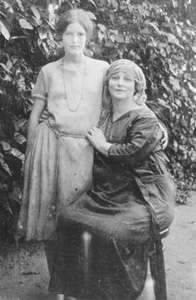May Maxwell

Mary "May" Maxwell (née Bolles; born 14 January 1870 in Englewood, New Jersey; died 1 March 1940 in Buenos Aires, Argentina) was an early American member of the Bahá'í Faith.[1]
Early life
Mary Ellis Bolles was born to John Bolles and Mary Martin Bolles, in Englewood, New Jersey.[2] She was nicknamed 'May' to distinguish her from her mother. May was of English ancestry. The Bolles family were distinguished in New York City, owning a successful bank in the city.[3] When she was fourteen May was sent to England to live with her English cousins. For one year May lived in Kensington. May became very spiritually minded; she was given a gift of a Bible in 1885, which she studied and read daily.[4]
As May approached her late teens, her family saw it was the time for her to be married. Phoebe Hearst, who was a close friend of her mother, funded May’s extravagant debutante ball. She was 'brought out' in Washington. May was considered a great beauty with a petite figure, blue eyes and long fair hair attracting several suitors who courted her.[5] The rejection of several marriage proposals frustrated her family. She was bought out again into Newport society in the hopes of finding a husband. May fell in love during this period and became engaged, but it was broken off. May plunged into depression, and it was around this time that her health seriously deteriorated.[6]
In late 1894, May moved to Paris with her mother and brother; who was attending the École des Beaux-Arts.[7] May’s mother still hoped for her to marry, but May resented the Parisian high society. She went through periods of deep depression and insomnia and even considered entering a convent. In 1897 May lost both her grandmother and cousin whom she was very close to. At 27 May became obsessed with mortality and became bedridden leading to many of her family members believing she was going to die.[8]
Pilgrimage to Acre
In November 1898, Phoebe Hearst, accompanied by her nieces and other Bahá’ís like Lua Getsinger, stopped off at Paris before concluding their journey to the East. Hearst was shocked to see 28-year-old May bedridden with the chronic malady which had inflicted her.[9] She invited May to sojourn to the East with her believing the change of air to be conducive to her health. Getsinger also disclosed to May the purpose of the journey; a pilgrimage to visit the head of the Bahá’í religion `Abdu'l-Bahá.[10] May arrived in Acre in February 1899. She wrote of the first time she met `Abdu’l-Bahá as "of that first meeting I can remember neither joy nor pain nor anything that I can name".[2]
As a Bahá’í
May returned to Paris and began teaching her new faith and played a significant role in introducing the religion to several people while in Paris. See Bahá'í Faith in France. Her teaching acquired many new believers, including Englishman Thomas Breakwell and Juliet Thompson.[1] On her return five of the younger female pilgrims had a photograph commissioned and sent to `Abdu'l-Bahá. On receiving the photograph he wrote a tablet addressed to the five, whom he named the Five Holy Leaves. She met a close friend of her brother's, William Sutherland Maxwell, a Canadian of Scottish background, and the two married in 1902 in London.[1][7] William did not become a Bahá'í until 1909. The couple had one child, a daughter named Mary.[2]
The couple moved to Montreal, and May set up a Bahá’í center in her home. Prior to 1912, she supported a Children’s Court for Montreal, and her efforts were chief in maintaining the Colborne Street Milk Station.[2] In about 1914, she brought a Montessori teacher from New York to their home in Montreal to start the first school of this type in Canada.[2] In Montreal May continued to convert people such as Arthur Armstrong, Rose Henderson and her husband’s cousin Martha MacBean. In 1912 `Abdu'l-Bahá visited Canada and stayed with the Maxwells. She was an early participant at Green Acre, the first Bahá'í training facility in the United States. In 1927 she was a member of the US and Canada National Spiritual Assembly.[7]
In 1937, her life changed dramatically after her daughter, Mary, was married to Shoghi Effendi, then head of the Bahá'í Faith.[2][7]
Death
Despite poor health, May chose to go to Buenos Aires to teach the Faith along with her niece.[7] However whilst arriving, May fell ill and died of a heart attack.[1] Shoghi Effendi gave her the status of martyr.[1][7]
Notes
- 1 2 3 4 5 Smith, Peter (1999). A Concise Encyclopedia of the Bahá'í Faith. Oxford, UK: Oneworld Publications. ISBN 1-85168-184-1.
- 1 2 3 4 5 6 "May Maxwell (1870-1940)". Bahá'í Community of Canada. Retrieved 2008-07-05.
- ↑ Hogenson, Kathryn J. (2010), Lighting the Western Sky: The Hearst Pilgrimage & Establishment of the Baha'i Faith in the West, George Ronald, ISBN 978-0-85398-543-3
- ↑ Nakhjavani, Violette (1996). Maxwells of Montreal, The. George Ronald. pp. 46–51. ISBN 978-0-85398-551-8.
- ↑ Nakhjavani, p.47
- ↑ Hogenson, p.58
- 1 2 3 4 5 6 Van den Hoonaard, Willy Carl (1996). The Origins of the Bahá'í Community of Canada, 1898-1948. Wilfrid Laurier University Press. pp. 36–39. ISBN 0-88920-272-9.
- ↑ Nakhjavani, p.52
- ↑ Hogenson, p.60
- ↑ Nakhjavani, p.70
